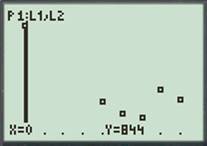
(a)
To graph: A
(a)
Explanation of Solution
Given information:
Below table gives the total amount of U.S. exported wheat products in metric tons for several years:
| U.S. Exported Wheat Products | |
| Year | Exported Wheat Products(metric tons) |
Graph:
To graph the points on scatter plot, follow the steps using graphing calculator.
First press the
Go to
Now, press the

Figure (1)
(b)
To find: The slope of the secant line
(b)
Answer to Problem 37E
The slope of the secant line
Explanation of Solution
Given information:
Below table gives the total amount of U.S. exported wheat products in metric tons for several years:
| U.S. Exported Wheat Products | |
| Year | Exported Wheat Products(metric tons) |
The point
Calculation:
Simplify the slope of the secant line
So, the slope of the secant line
Simplify the slope of the secant line
So, the slope of the secant line
Simplify the slope of the secant line
So, the slope of the secant line
Therefore, the slope of the secant line
Chapter 2 Solutions
Calculus 2012 Student Edition (by Finney/Demana/Waits/Kennedy)
Additional Math Textbook Solutions
Single Variable Calculus: Early Transcendentals (2nd Edition) - Standalone book
Precalculus (10th Edition)
Calculus: Early Transcendentals (3rd Edition)
Calculus & Its Applications (14th Edition)
University Calculus: Early Transcendentals (3rd Edition)
 Calculus: Early TranscendentalsCalculusISBN:9781285741550Author:James StewartPublisher:Cengage Learning
Calculus: Early TranscendentalsCalculusISBN:9781285741550Author:James StewartPublisher:Cengage Learning Thomas' Calculus (14th Edition)CalculusISBN:9780134438986Author:Joel R. Hass, Christopher E. Heil, Maurice D. WeirPublisher:PEARSON
Thomas' Calculus (14th Edition)CalculusISBN:9780134438986Author:Joel R. Hass, Christopher E. Heil, Maurice D. WeirPublisher:PEARSON Calculus: Early Transcendentals (3rd Edition)CalculusISBN:9780134763644Author:William L. Briggs, Lyle Cochran, Bernard Gillett, Eric SchulzPublisher:PEARSON
Calculus: Early Transcendentals (3rd Edition)CalculusISBN:9780134763644Author:William L. Briggs, Lyle Cochran, Bernard Gillett, Eric SchulzPublisher:PEARSON Calculus: Early TranscendentalsCalculusISBN:9781319050740Author:Jon Rogawski, Colin Adams, Robert FranzosaPublisher:W. H. Freeman
Calculus: Early TranscendentalsCalculusISBN:9781319050740Author:Jon Rogawski, Colin Adams, Robert FranzosaPublisher:W. H. Freeman
 Calculus: Early Transcendental FunctionsCalculusISBN:9781337552516Author:Ron Larson, Bruce H. EdwardsPublisher:Cengage Learning
Calculus: Early Transcendental FunctionsCalculusISBN:9781337552516Author:Ron Larson, Bruce H. EdwardsPublisher:Cengage Learning





